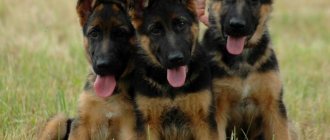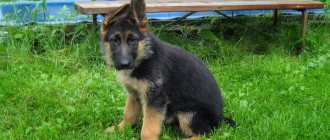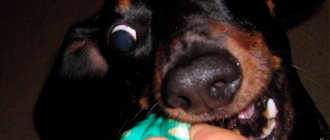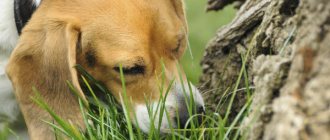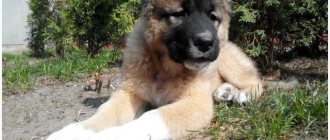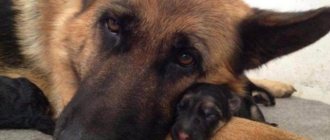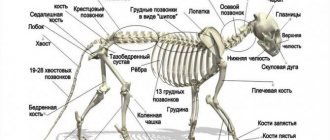Every puppy owner will have to go through a very important period - the change of baby teeth to molars. If this process is not controlled, the dog may develop bite defects. And this leads not only to disqualification at the exhibition, but also to rapid grinding of teeth and the appearance of various dental diseases.
Recommendations from veterinarians and experienced dog breeders will help you avoid dental problems and improve your German Shepherd puppy’s well-being during teeth changes.
How many teeth do German Shepherds have?
Adult representatives of the breed have only 42 teeth:
- 20 located on the upper jaw;
- 22 – on the bottom.
If you mentally divide the jaw into 2 parts with a longitudinal line, then the location of the teeth will be as follows:
- 3 incisors each;
- 1 fang each;
- 4 premolars each;
- 2 molars on top and 3 on bottom.
To record the dental formula, special notations are used:
- incisors (Incisivi) – I;
- fangs (Caninus) – C;
- premolars (Praemolares) – P;
- molars (Molares) – M.
The arrangement of teeth on the jaws, prescribed in this way, looks like this:
- 4M, 8P, 2C, 6I – upper;
- 6M 8P 2C 6I – lower.
German Shepherds have a scissor bite - when the jaws are closed, the upper incisors overlap the lower ones in a scissor-like manner.
This arrangement promotes thorough chewing of food, prevents injuries to the soft tissues of the oral cavity, and provides a good grip.
Invalid:
- overshot – the lower incisors protrude beyond the line of the upper incisors;
- undershot – the lower incisors do not reach the upper ones: they do not touch, leaving a pronounced gap;
- direct bite - the surfaces of the incisors of both jaws touch when closed;
- large gaps between teeth (more than 3 mm).
For your information. To make sure that the puppy will not have bite problems, you should ask the breeder to provide photographs of the parents' jaws (preferably two generations) and an x-ray of the baby's jaws, proving that he will be fully edentate.
According to the breed standard, incomplete dental formula is considered a serious fault. A German Shepherd is disqualified if it lacks:
- third premolar and next tooth;
- fang;
- fourth premolar;
- first molar;
- second molar;
- 3 or more teeth.
These rules do not apply if the German Shepherd has lost a tooth due to injury. In this case, the owner must provide a certificate certified by the seal of the veterinary clinic and an x-ray.
How many teeth does a shepherd dog have?
All puppies are born toothless. As they grow, they first develop baby teeth, which are necessary for the proper formation of the jaw bones. Already at the age of one and a half months, a shepherd puppy has a full set of teeth, consisting of 14 copies on each jaw.
The temporary elements of the dental system are divided into incisors, canines and premolars.
The puppy does not have chewing teeth; they will appear only by six months. If molars erupt along with deciduous teeth, it means that they will never be replaced by molars. Dogs with this defect are excluded from the breeding program.
, 28 milk teeth must grow before the change . Although deviations in quantity are acceptable, both up and down. This is not a sign that the puppy will remain toothless for the rest of his life; most likely, the problem will resolve itself with age.
Puppy's milk teeth
How many teeth should an adult shepherd ? Exactly 42 teeth . The absence of any element other than a small premolar is not allowed. But there are exceptions to this rule. During protective guard training or overly active games, there are often cases of damage to the integrity of teeth under the influence of external factors. Therefore, if there are documents confirming the traumatic nature of the missing tooth, the exhibition rating will not be reduced.
Such documents include:
- a certificate from a veterinarian describing the injury, certified by the clinic’s seal;
- X-ray.
However, many experts will not understand the nature of missing teeth, and the dog will receive a low score in the ring.
Symptoms of tooth change
During the period of teeth change, the immunity of a German Shepherd puppy weakens, since this is a serious stress for the body.
The process may be accompanied by the following symptoms:
- decreased appetite;
- indigestion;
- slight increase in body temperature;
- restless and apathetic behavior;
- smell from the mouth;
- itching in the gums, manifested in the desire to gnaw on any objects;
- drowsiness, low activity;
- falling ears.
During the shift, the appetite decreases due to the discomfort that the puppy experiences when chewing. This is normal as long as the German Shepherd remains cheerful and only refuses food, not water.
Malfunctions in the digestive system can be associated both with shifts and with infection. When diarrhea is accompanied by fever and vomiting, it is necessary to take your puppy to the vet.
If the disorder goes away without complications, it is enough to provide the German Shepherd with plenty of fluids - in case of diarrhea, water is quickly eliminated from the body. After some time, the puppy’s condition returns to normal.
An unpleasant odor from the mouth of a German Shepherd also appears due to several reasons:
- Stuck food rots;
- Pathogenic bacteria multiply in the oral cavity, destroying tooth enamel;
- the gastrointestinal tract does not function properly (usually with an unbalanced diet).
If no abnormalities are detected, but the problem does not go away, you should seek help from a veterinarian.
Changing teeth
General recommendations for owners for this period:
- refrain from physical activity;
- reduce the time of walking and training;
- refrain from playing tug of war.
When dogs get new canines, it is very easy to mess up their bite by accidentally pushing a growing tooth into the wrong position.
Feeding during teeth change
During this period, puppies fed natural food and economy-class food are supplemented with mineral supplements with calcium, phosphorus and fluorine. If a puppy is fed premium and super premium dry food, then supplements are included in the diet only on the advice of a veterinarian or breeder. An excess of calcium, as well as a deficiency, can cause an allergic reaction or lead to osteoarticular diseases.
In what order do teeth change?
The incisors grow first. Approximately this lasts from 3.5 to 5 months. Then comes the turn of the fangs. They must wait from 5 to 7 months. Simultaneously with the fangs, chewing teeth (molars) appear. At 6–8 months, premolars fall out.
Until what age do teeth grow?
Large breed dogs usually tolerate tooth changes faster and easier than small ones. Therefore, at the age of 8 months, the shepherd's teeth should completely change .
If by 9 months permanent canines and molars have not yet grown, this may indicate a pathology that requires medical intervention.
What to feed during the period of teeth change
Eating inappropriate food during the period of teeth growth in a German Shepherd can lead to the formation of bite defects.
Veterinarians claim that food rich in essential vitamins and minerals corrects deficiencies in half the cases.
If the puppy eats natural products or economy-class food, during the change period the diet includes food additives containing:
- calcium;
- phosphorus;
- fluorine.
The use of these elements during a shift strengthens tooth enamel, reduces the likelihood of malocclusion, caries and periodontal disease. Before you start taking it, you should consult your veterinarian - he will indicate the exact dosage for the puppy.
After all, both a lack and an excess of nutrients have a negative effect on the body of a German Shepherd.
To keep the puppy healthy during the shift, add the following to the food:
- live yeast;
- fish fat;
- crushed ascorbic acid;
- B vitamins;
- sea buckthorn oil.
No more than 3 drugs are given at the same time - they will not be absorbed in larger quantities.
If chewing causes severe discomfort to your German Shepherd puppy and he refuses food, you can temporarily switch the dog to feeding soft foods - meat broths, kefir, liquid porridges.
When the unpleasant symptoms subside, solid food is returned to the diet. The shift is delayed if the German Shepherd puppy eats only soft food. They do not provide the necessary load on the jaws and do not train the muscles, which is why the process does not finish on time.
To accelerate the growth and strengthening of molars, the puppy is allowed to periodically gnaw:
- large beef bones that cannot be chewed and swallowed;
- raw vegetables - apples, carrots (this is also an additional source of vitamins);
- chewable treats sold in pet stores - bones, sticks;
- durable toys (it is better to change them every few days so that the baby does not get bored with the game).
But sticks, stones and other hard objects should be kept away. Bones should be excluded from the puppy’s diet when the canine teeth begin to change. They can form incorrectly and become thinner due to heavy stress.
Important. Neither puppies nor adult German Shepherds should be given long bones. It will not be difficult for a dog to chew them, and the sharp fragments injure the esophagus and mucous membranes.
When consuming high-quality food (premium, superpremium, holistic), the dog does not need mineral supplements. Such products already contain the necessary components in optimal quantities.
Changing teeth in a German Shepherd
The change of teeth in a German Shepherd begins in the midst of a period of active growth. From 14 weeks of age, the puppy quickly (mostly in leaps and bounds) increases in size. His muscular skeleton is formed, his paws grow, his chest bones and skull bones grow.
Small, fragile puppy teeth are replaced by impressive, strong fangs. This stage usually ends simultaneously with the appearance of a full set of molars. The dog's further development occurs at a slower pace.
How to help a dog
Helping a German Shepherd puppy during teething includes:
- in reducing the duration of walking and training sessions;
- reducing physical activity;
- excluding games with dragging objects.
It is useful to rock a loose baby tooth with a finger wrapped in a sterile bandage. The process is turned into a game so that the puppy does not develop negative associations.
The tooth is pulled out when it is separated from the gum without effort, and it must be pulled not upward, but to the side. If it wobbles, but still sits confidently in place, it is better not to touch it. There is a high risk of breaking off a piece that will remain in the jaw. Then you will have to resort to surgery.
You can buy a special teether for your German Shepherd puppy. This is a hollow toy made of durable plastic and filled with water. It is kept in the refrigerator and then given to the dog. With its help, the animal will get rid of itching in the gums and pain.
Possible complications
When changing teeth, a German Shepherd puppy needs the attention and care of its owner. In addition to general malaise, the dog may develop other problems.
Baby teeth do not always fall out on their own. Contrary to popular belief, they have roots that dissolve over time and serve as the basis for the formation of permanent teeth during the change period.
Due to genetic characteristics or errors in care, the root may not resolve. In this case, the help of a specialist is required. The lack of adequate measures leads to malocclusion and the appearance of dental diseases.
Experts note other anomalies:
- The baby teeth remain in place, and the molars appear next to them. The so-called false polydontia (multi-teeth) is formed. However, this pathology is extremely rare in German Shepherd puppies. Mostly owners of small breeds face it.
- False polydontia occurs on some teeth. Most often it affects the dog's incisors and/or canines.
- The full change is completed only by 1-1.5 years. Usually, fangs or incisors do not fall out in a timely manner.
- The animal remains with milk teeth for the rest of its life. In most cases, the problem concerns the fangs.
False polydontia is accompanied by dystopia - the growth of molars in an atypical place. They usually move forward or backward.
It is allowed to remove a milk tooth when the crown of the molar is already visible next to it. If it is not yet noticeable, the operation is postponed - there is a high risk of injuring the tooth germ. Chipped or broken teeth are removed from the gums using any available method.
Important. It is necessary to get rid of everything unnecessary before the puppy is 9 months old, that is, while the shift has not yet completed, otherwise the bite will not be restored.
Sometimes the change is delayed - the molar tooth is felt in the gum, but does not appear on the surface. Experts categorically do not recommend making an incision yourself - the wound will quickly heal, and as long as it remains open, it can become infected.
It is better to treat the problem area with a special stick - you can buy it at the pharmacy. The procedure is completely painless and stimulates teething well.
If this method does not help, contact a veterinarian. The specialist will take an x-ray and operate on the puppy under anesthesia.
An abnormal change of teeth in a German Shepherd is fraught not only with an incorrect bite, but also with other problems:
- weakness of enamel;
- the appearance of tartar;
- caries (bacterial damage to hard tissues);
- pulpitis (inflammation and death of dental tissue);
- periodontitis (inflammation of periodontal tissues);
- periodontal disease (inflammatory disease leading to periodontal atrophy);
- cheilitis (inflammation of the mucous membrane at the edge of the lip);
- gingivitis (inflammation of the gums);
- stomatitis (inflammation of the mucous membranes of the mouth).
During the shift period, it is important to regularly examine the oral cavity in order to detect pathology in time and take appropriate measures.
A German Shepherd puppy should be taken to the vet if any of the following symptoms appear:
- redness of the entire surface of the gums, and not just the eruption points;
- change in tooth color;
- bleeding gums.
Other warning signs include fever and complete refusal to eat for several days.
